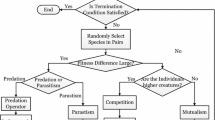Abstract
There continues to be a growing interest in the use of co-evolutionary algorithms to solve difficult computational problems. However, their performance has varied widely from good to disappointing. The main reason for this is that co-evolutionary systems can display quite complex dynamics. Therefore, in order to efficiently use co-evolutionary algorithms for problem solving, one must have a good understanding of their dynamical behavior. To build such understanding, we have constructed a methodology for analyzing co-evolutionary dynamics based on trajectories of best-of-generation individuals. We applied this methodology to gain insights into how to tune certain algorithm parameters in order to improve performance.
Similar content being viewed by others
References
Alligood K, Sauer T and Yorke J (1996) Chaos: An Introduction to Dynamical Systems, Springer
Angeline PJ and Pollack JB (1994). ‘Coevolving high-level representations’. In: Langton C.G. (eds), Artificial Life III, Vol. XVII. Santa Fe, New Mexico, Addison-Wesley, pp. 55–71
Bucci A and Pollack J (2002) Order-theoretic analysis of coevolution problems: coevolutionary statics. In: Langdon WB et al. (eds) Genetic and Evolutionary Computation Conference Workshop: Understanding Coevolution, Morgan Kaufmann
Cliff D and Miller GF (1994) Co-evolution of Pursuit and Evasion I: Biological and Game-theoretic Foundations. Technical Report, School of Cognitive and Computing Sciences, University of Sussex
Cliff D and Miller GF (1995) Tracking the red queen: measurements of adaptive progress in co-evolutionary simulations. European Conference on Artificial Life, pp. 200–218
Ficici S, Melnik O and Pollack J (2000) A game-theoretic investigation of selection methods used in evolutionary algorithms. In: Zalzala eaA (ed.) Proc. of CEC2000, IEEE Press
Ficici SG and Pollack JB (1998) Challenges in coevolutionary learning: arms-race dynamics, open-endedness, and mediocre stable states. In: Adami C, Belew RK, Kitano H and Taylor C (eds) Artificial Life VI: Proc. of the Sixth Int. Conf. on Artificial Life, The MIT Press, Cambridge, MA, pp. 238–247
Hillis WD (1990) Co-evolving parasites improve simulated evolution as an optimization procedure. In: CNLS ’89: Proceedings of the Ninth Annual International Conference of the Center for Nonlinear Studies on Self-organizing, Collective, and Cooperative Phenomena in Natural and Artificial Computing Networks on Emergent Computation, North-Holland Publishing Co., pp. 228–234
Hofbauer J and Sigmund K (1998) Evolutionary Games and Population Dynamics, Cambridge University Press
Luke S and Wiegand RP (2003) When Coevolutionary Algorithms Exhibit Evolutionary Dynamics. In: Workshop Proceedings of the Genetic and Evolutionary Computation Conference (GECCO-2003), Springer
Pagie L and Mitchell M (2002). ‘A comparison of evolutionary and coevolutionary search’. International Journal of Computational Intelligence and Applications 2(1): 53–69
Panait L, Wiegand RP and Luke S (2004) A sensitivity analisys of a cooperative coevolutionary algorithm biased for optimization. In: Proceedings of the Genetic and Evolutionary Computation Conference – GECCO-2004
Popovici E and De Jong K (2004) Understanding competitive co-evolutionary dynamics via fitness landscapes. In: Luke S (ed.) AAAI Fall Symposium on Artificial Multiagent Learning, AAAI Press
Popovici E and De Jong K (2005a) A dynamical systems analysis of collaboration methods in cooperative co-evolution. In: AAAI Fall Symposium Series Co-evolution Workshop, AAAI Press
Popovici E and De Jong K (2005b) relationships between internal and external metrics in co-evolution. In: Congress on Evolutionary Computation, pp. 2800–2807, IEEE Press
Popovici E and De Jong K (2005c). Understanding cooperative co-evolutionary dynamics via simple fitness landscapes. In: Beyer H.-G. et al. (eds), Proceedings of the Genetic and Evolutionary Computation Conference, GECCO-2005. New York, ACM Press
Potter M and De Jong K (1994) A cooperative coevolutionary approach to function optimization. In: Proceedings of the Third Conference on Parallel Problem Solving from Nature (PPSN III), Jerusalem, Israel, pp. 249–257, Springer
Rosin CD and Belew RK (1995) Methods for competitive co-evolution: finding opponents worth beating. In: Proceedings of the 6th International Conference on Genetic Algorithms, Morgan Kaufmann Publishers Inc., pp. 373–381
Sims K. (1994). ‘Evolving 3D morphology and behaviour by competition’. In: Brooks R. and Maes P. (eds), Artificial Life IV Proceedings. MIT, Cambridge, MA, USA, MIT Press, pp. 28–39
Wiegand RP (2004) An analysis of cooperative coevolutionary algorithms. Ph.D. thesis, George Mason University, Fairfax, VA
Wiegand RP, Liles W and De Jong K (2002) Analyzing cooperative coevolution with evolutionary game theory. In: Proceedings of the Congress on Evolutionary Computation, IEEE Press, pp. 1600–1605
Wiegand RP and Sarma J (2004). ‘Spatial embedding and loss of gradient in cooperative coevolutionary algorithms’. In: Yao X et al. (eds), 8th International Conference on Parallel Problem Solving from Nature - PPSN VIII. Birmingham, UK, Springer, pp. 912–921
Acknowledgements
We would like to thank: Gabriel Balan, for pointing out the “best-response” terminology as appropriate for our work; An anonymous reviewer of our paper (Popovici and De Jong, 2005a), for suggesting parameterizing the angle between the best-response curves; Jayshree Sarma, for proof reading the manuscript and providing useful comments that we incorporated for improving the paper.
Author information
Authors and Affiliations
Corresponding author
Rights and permissions
About this article
Cite this article
Popovici, E., Jong, K.D. The dynamics of the best individuals in co-evolution. Nat Comput 5, 229–255 (2006). https://doi.org/10.1007/s11047-006-9000-1
Published:
Issue Date:
DOI: https://doi.org/10.1007/s11047-006-9000-1




